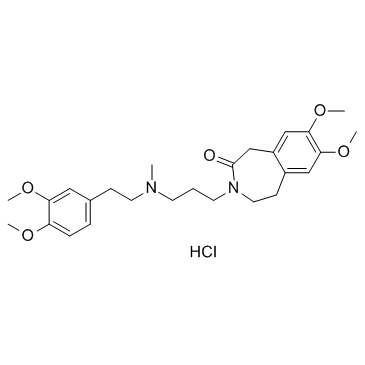91940-87-3
| Name | 3-[3-[2-(3,4-dimethoxyphenyl)ethyl-methylamino]propyl]-7,8-dimethoxy-2,5-dihydro-1H-3-benzazepin-4-one,hydrochloride |
|---|---|
| Synonyms |
Zatebradine dihydrochloride
Zatebradine hydrochloride UL-FS49 Zatebradine (hydrochloride) |
| Description | Zatebradine(UL-FS49) Hcl is a potent HCN channels antagonist, which decreased the heartbeat in a reversible manner; 92% inhibition of the hHCN1-mediated current at 10 uM.IC50 value: 10 uM(92% 92% inhibition of the hHCN1) [1]Target: hHCN channel antagonistThe pharmacological properties of hHCN1-mediated currents resembled those of native hyperpolarization-activated currents (I(h)), that is, blockade by Cs(+) (99% at 5 mm), ZD 7288 (98% at 100 microm) and zatebradine (92% at 10 microm) [1]. When voltage-clamp pulse trains were applied, cilobradine induced a use-dependent blockade of If that was stronger and faster than that with zatebradine. Recovery from blockade during prolonged hyperpolarization was significantly faster with zatebradine [2]. The selective HCN blocker zatebradine reduced the activity of oriens-lacunosum moleculare interneurons in wild-type but not HCN2(-/-) mice and decreased the frequency of spontaneous inhibitory currents in postsynaptic CA1 pyramidal cells [3]. |
|---|---|
| Related Catalog | |
| References |
| Density | 1.115g/cm3 |
|---|---|
| Boiling Point | 612.5ºC at 760mmHg |
| Molecular Formula | C26H37ClN2O5 |
| Molecular Weight | 493.03500 |
| Flash Point | 324.3ºC |
| Exact Mass | 492.23900 |
| PSA | 60.47000 |
| LogP | 3.95270 |
| Personal Protective Equipment | Eyeshields;Gloves;type N95 (US);type P1 (EN143) respirator filter |
|---|---|
| Safety Phrases | 22-24/25 |
| RIDADR | NONH for all modes of transport |
| WGK Germany | 3 |
